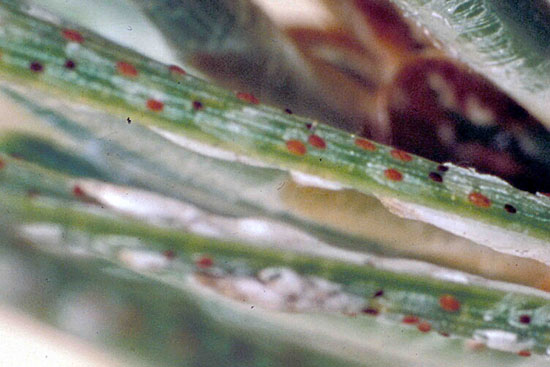Issue 3, May 15, 2017
Insects Susceptible to Control
The bloom of bridal wreath spirea, or Vanhoutte spirea (Spiraea x vanhouttei), is a major phenology event in Don Orton's book Coincide. With phenology, stages of plant development (usually bloom time) are used to predict stages in pest development. This method is typically more accurate than using calendar dates because plants are exposed to the same climatic conditions as insects. Thus, "early" and "late" springs associated with unusually high or low temperatures, respectively, cause similar responses in both plant and insect.
However, as has been presented in the first two issues of this year's newsletter, the abnormally long period of high temperatures in the 40's and low 50's degrees F this year has thrown off phenology timing. Bridal wreath spirea would be typically blooming now in central Illinois, but it bloomed the week of April 23. Coincide also lists degree-day numbers for the various pests. These should be followed this year rather than the phenology plant information.
Insects do not develop at temperatures much below 50 degrees F so they were not developing during the weeks with highs in the 40's and low 50's degree F, but the plants were developing during that time. Although insects were developing somewhat ahead of normal with extra daytime highs above 50 degrees F, they slowed down during the last couple of weeks of abnormally cool weather. They are becoming active at about the same time as in a normal year in northern Illinois, about four days ahead in central Illinois, and about ten days ahead of normal in southern Illinois.

Pine needle scale crawlers.
Pest occurrences cited in this newsletter do not constitute a spray guide. When a pest is reported to be susceptible to control, one needs to scout to verify that the pest is present and in a susceptible stage before using a control measure.
Following are the most common pests that are in susceptible treatment stages during this time. The dates listed are likely to be those of peak susceptibility. Pests are usually susceptible to control for a longer time than those listed.
Suggestions are listed for central Illinois. Typically, these occurrences are two weeks earlier in southern Illinois and two weeks later in northern Illinois.
May 10-12: Birch leafminer young larvae; elm leaf beetle young larvae; European pine sawfly feeding larvae; gypsy moth feeding larvae; pine needle scale crawlers (first generation), black turfgrass ataenius (first generation).
May 13-15: Lilac (ash) borer newly hatched larvae; oystershell scale (brown) crawlers; emerald ash borer adult beginning emergence.
May 16-19: Bronze birch borer newly hatched larvae.
May 20-22: Flat-headed appletree borer larval hatch; peach tree borer newly hatched larvae; viburnum borer newly hatched larvae.
May 23-25: Oystershell scale (gray) crawlers. (Phil Nixon)
Author:
Phil Nixon